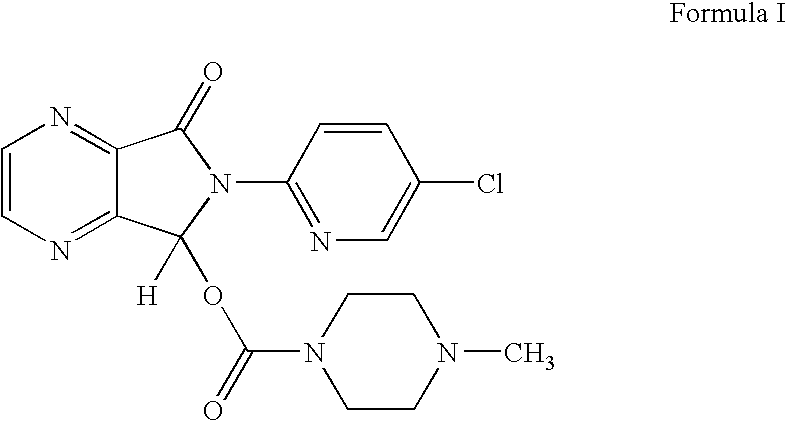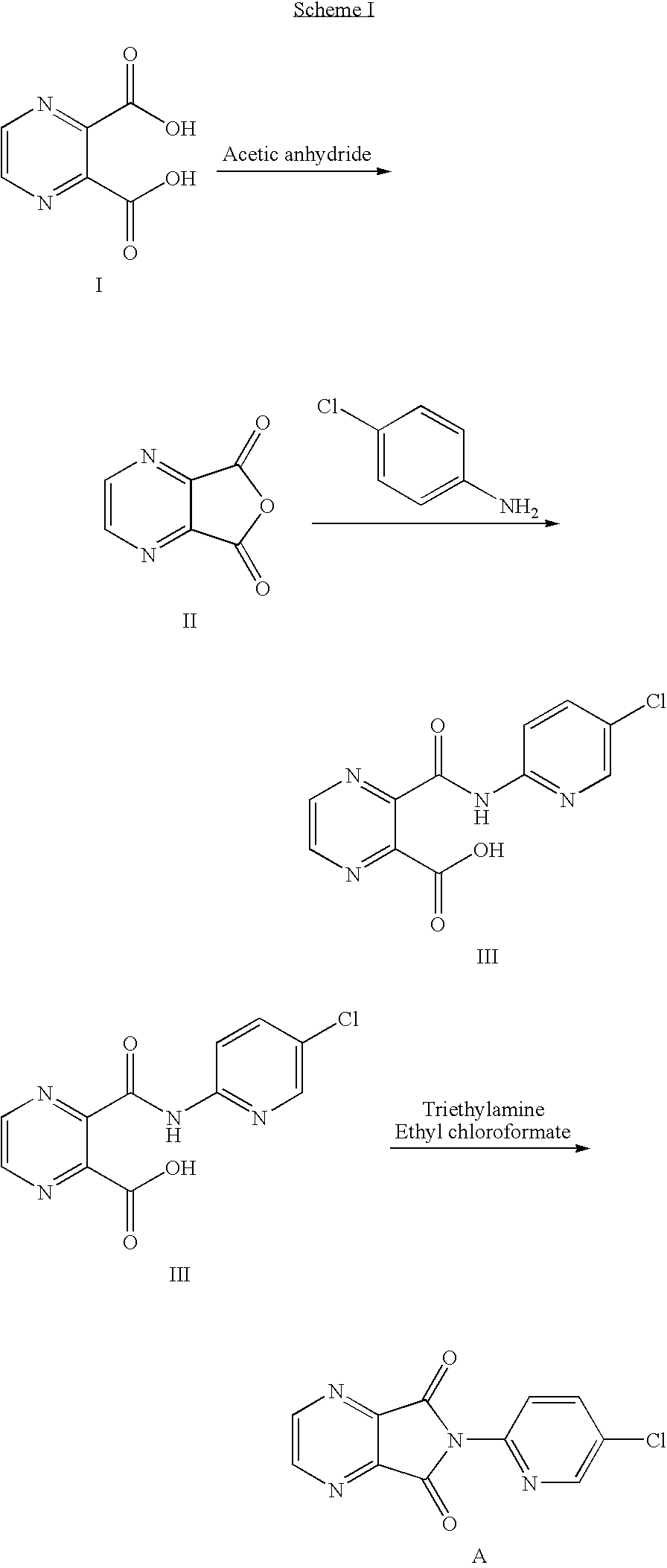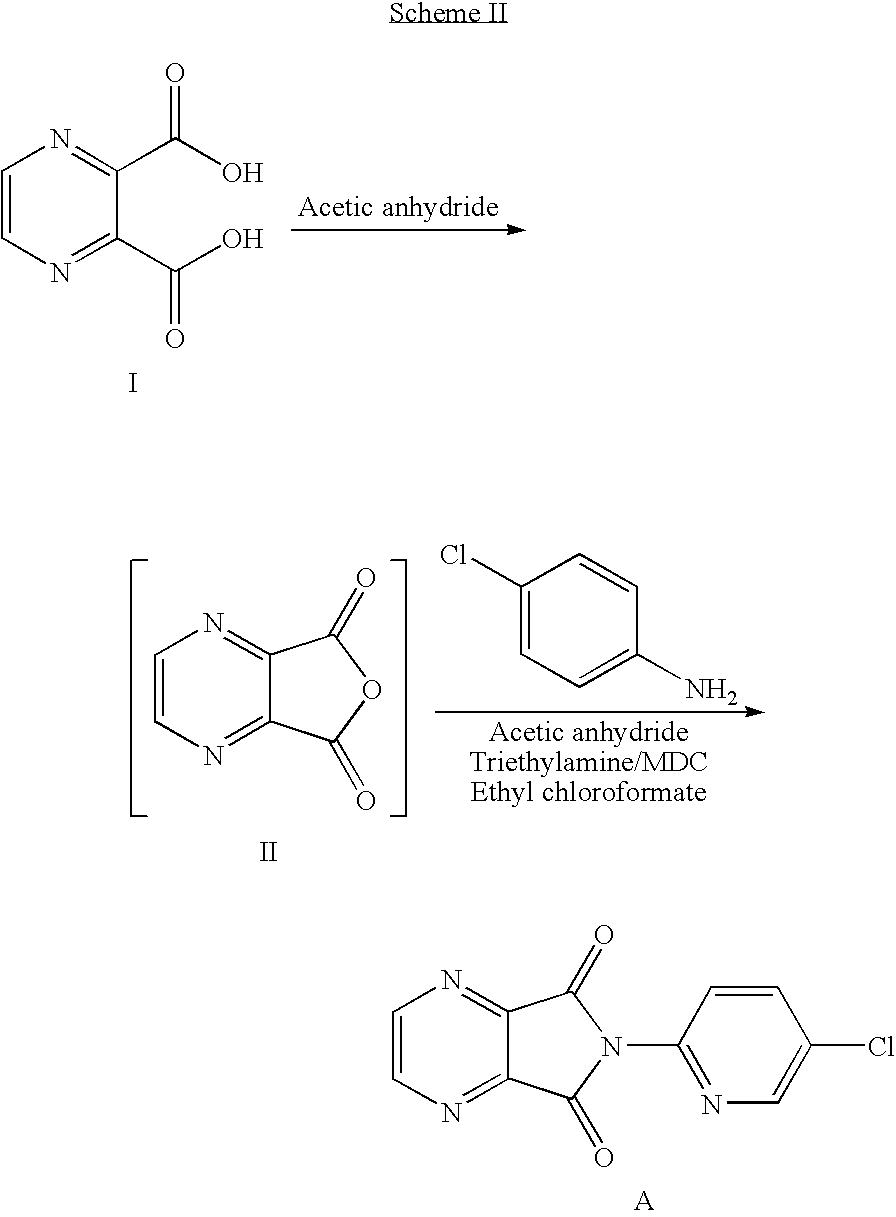Process for the preparation of eszopiclone
a technology of eszopiclone and eszopiclone, which is applied in the field of process for the preparation of eszopiclone, can solve the problems of poor yield of the final product zopiclone, thionyl chloride is toxic, corrosive, and difficult to handle when used on an industrial scale, and achieves high yield and purity. high, cost-effective
- Summary
- Abstract
- Description
- Claims
- Application Information
AI Technical Summary
Benefits of technology
Problems solved by technology
Method used
Image
Examples
example 1
Preparation of 3-(5-chloropyrid-2-yl)carbamoyl-pyrazine 2 carboxylic acid
[0057]In a clean, dry 500 ml R. B. flask charged acetic anhydride (162 gms) and pyrazine-2,3, dicarboxylic acid (50 gins). The reaction mass was heated to 100-120° C. up to completion of reaction. After completion of the reaction, the excess acetic anhydride was distilled under vacuum. Charged methylene dichloride (350 ml) to the above reaction mass followed by 2-amino-5-chloropyridine (40 gms) in a lot wise manner at room temperature for 30 min. The reaction mass was stirred at room temperature for 2 hrs; the reaction mixture was cooled to 5-10° C. for 1 hr. The reaction mixture was filtered and washed with chilled methylene dichloride to obtain 3-(5-chloropyrid-2-yl)carbamoyl-pyrazine-2-carboxylic acid.
[0058]Yield=82 gms.
example 2
Preparation of 6-(5-chloropyrid-2-yl) 5,7-dioxo-5,6-dihydropyrrolo[3,4-b]-pyrazine
[0059]In a clean 500 ml R. B. flask charged pyrazine-2,3-dicaroxylic acid (50 gms) and acetic anhydride (162 gms). The reaction mass was heated to 110-120° C. till the completion of reaction to get pyrazine-2,3-dicarboxylic acid anhydride. After completion of the reaction, excess acetic anhydride was distilled out under vacuum and furthermore charged with methylene dichloride (315 ml) and 2-amino-5-chloropyridine (40 gms) in a lot wise manner at room temperature for 30 min. Further, the reaction mixture was stirred for 2 hours at room temperature. The reaction mass was cooled to 5 to 10° C. for one hour, the product was filtered and washed with chilled methylene dichloride. The solid was charged with methylene dichloride (235 ml), triethylamine (40.9 ml) at a temp. of 0-5° C. followed by ethyl chloroformate (28.1 ml). The reaction mass was stirred at 0-5° C. for 1 hr, water (200 ml) was added to the re...
example 3
Preparation of Zopiclone
[0062]Charged 1.0 Kg (3.81 moles) of 6-(5-chloropyridyl-2-yl)-5-hydroxy-7-oxo-5,6-dihydro-pyrrolo[3,4b]pyrazine in 10.0 L. of methylene chloride, and the reaction mixture was cooled to 5-10° C. 1.0 Kg of 1-chlorocarbonyl-4-methylpiperazine hydrochloride was added at the same temperature. 1.22 Kg (12 moles) of triethyl amine was added to the reaction mixture followed by adding N,N-dimethylamino pyridine (0.035 Kg) at temperature 5-10° C. in two lots. The reaction mixture was heated to reflux and maintained for 2 hrs. Reaction mixture was cooled to room temperature and 4.5 L. of water was added at 25° C. The organic layer was separated and the aqueous phase was extracted with methylene dichloride (2.0 L). The combined organic phase was washed with water (2.0 L), the organic phase was separated and concentrated at an atmospheric pressure to obtain crude zopiclone. The crude zopiclone was recrystallized from ethyl acetate and further purified from isopropanol (Yi...
PUM
| Property | Measurement | Unit |
|---|---|---|
| molar ratio | aaaaa | aaaaa |
| temperature | aaaaa | aaaaa |
| temperature | aaaaa | aaaaa |
Abstract
Description
Claims
Application Information
 Login to View More
Login to View More - R&D
- Intellectual Property
- Life Sciences
- Materials
- Tech Scout
- Unparalleled Data Quality
- Higher Quality Content
- 60% Fewer Hallucinations
Browse by: Latest US Patents, China's latest patents, Technical Efficacy Thesaurus, Application Domain, Technology Topic, Popular Technical Reports.
© 2025 PatSnap. All rights reserved.Legal|Privacy policy|Modern Slavery Act Transparency Statement|Sitemap|About US| Contact US: help@patsnap.com



